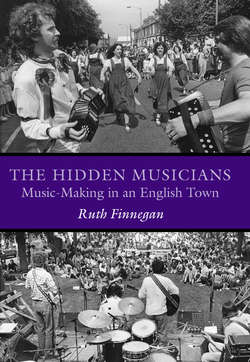Читать книгу The Hidden Musicians - Ruth Finnegan - Страница 17
На сайте Литреса книга снята с продажи.
Оглавление2
Musical worlds in Milton Keynes
This part gives some account of the differing musics in Milton Keynes in the early 1980s. It is difficult to know how to present the inevitably overlapping and heterogeneous material of so complex a study as that of the musical activities of a whole town. I finally decided to begin with a plain description of the main ‘musical worlds’ into which local music-making seemed broadly to be divided (in part 2) and then (in part 3) consider some of the contrasts and comparisons between them before going on to the further analysis in parts 4 and 5.
The idea of a musical ‘world’ partly arises from local participants’ own descriptions. Brass band involvement was ‘a world on its own’, and classical art music seen as a ‘quite different world’ from that of rock music. The term has also been used by anthropologists and others to refer to people’s ‘world view’ or to different ‘social worlds’, emphasising the differing and complex cultures of ideas and practice within which people variously live.1
This has been taken further in Howard Becker’s illuminating study of ‘art worlds’ (1982). Since the concept of musical ‘worlds’ has structured my presentation in this part, it is worth quoting Becker’s exposition:
Art worlds consist of all the people whose activities are necessary to the production of the characteristic works which that world, and perhaps others as well, define as art. Members of art worlds coordinate the activities by which work is produced by referring to a body of conventional understandings embodied in common practice and in frequently used artifacts …
The interaction of all the involved parties produces a shared sense of the worth of what they collectively produce. Their mutual appreciation of the conventions they share, and the support they mutually afford one another, convince them that what they are doing is worth doing. If they act under the definition of “art”, their interaction convinces them that what they produce are valid works of art. (Becker 1982, pp. 34, 39)
The ‘musical worlds’ of Milton Keynes were instances of such ‘art worlds’.2 They were distinguishable not just by their differing musical styles but also by other social conventions: in the people who took part, their values, their shared understandings and practices, modes of production and distribution, and the social organisation of their collective musical activities.
Part 2 therefore presents in turn some description of the various musical worlds of classical, brass band, folk, musical theatre, jazz, country and western, and rock or pop music which could with varying degrees of distinctiveness be found in Milton Keynes. Each is treated here as valid in itself, presented at least in part from the viewpoint of its participants. This approach is necessary for understanding the conventions in these differing worlds in their own terms, but it is also one that, surprisingly, cannot be taken for granted. ‘Music’ tends to be at once a word of approval and one that means different things to different people; what one group unambiguously define as ‘music’ may be rejected by others as not ‘really’ music, or as ‘mere noise’ or ‘childish’ or ‘just a boring series of notes’. It thus takes some detachment as well as self-education to envisage music right across the spectrum from ‘pop’ to ‘classical’ as equally valid, for this means refusing to accept any one set of assumptions about the ‘true’ nature of music and instead exploring each ‘world’ as of equal authenticity with others.
